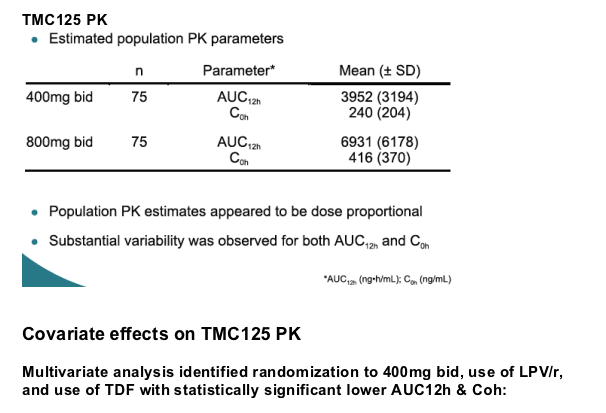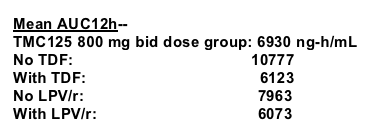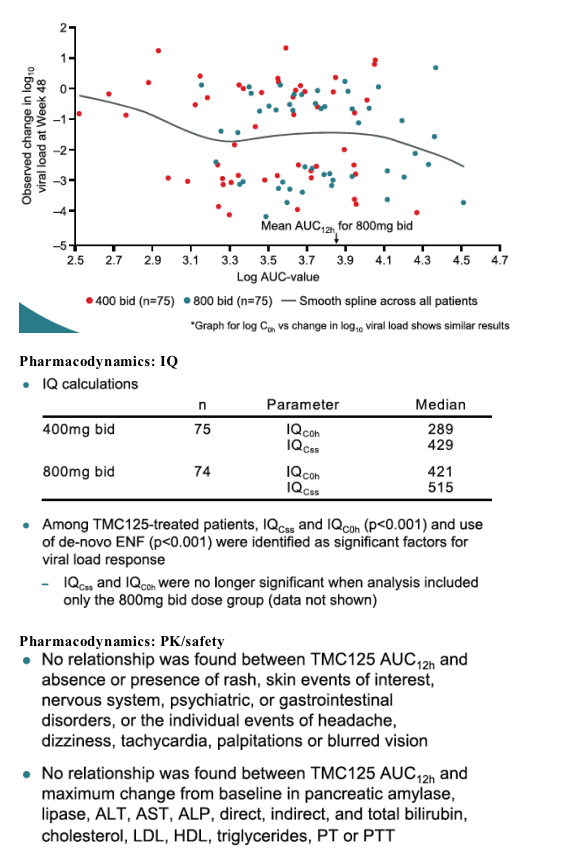 |
 |
 |
| |
TMC125, Tenofovir, LPV/r Interactions
|
| |
| |
Reported by Jules Levin
CROI, Feb 2007, Los Angeles
Pharmacokinetics and pharmacodynamics of TMC125 in HIV-infected patients with non-nucleoside reverse transcriptase inhibitor and protease inhibitor resistance: TMC125-C223
TN Kakuda,1 M Scholler-Gyure,2 M Peeters,2 J Vingerhoets,2 C Corbett,2 BJ Woodfall,2 RM Hoetelmans2
1Tibotec Inc, Yardley, USA; 2Tibotec BVBA, Mechelen, Belgium
Background
TMC125 is a next generation non-nucleoside reverse transcriptase inhibitor (NNRTI) with potent activity against both wild-type and NNRTI-resistant HIV. Study TMC125-C223 prospectively randomized 199 HIV-infected patients with NNRTI resistance and 33 primary protease inhibitor (PI) mutations at baseline to TMC125 (400mg or 800mg bid) with an investigator selected optimized background (OB) or standard-of-care control regimen. This analysis investigated demographic effects on TMC125 pharmacokinetic (PK) and pharmacodynamic (PD) relationships from this trial.
Methods
A population PK model for TMC125 was developed with Bayesian feedback for area under the plasma concentration-time curve from time of administration to 12 hours (AUC12h) and predose plasma concentration (C0h) from sparse sampling
collected over 48 weeks. Virologic response was defined as change in viral load from baseline, >1 log10 drop in viral load or proportion of patients with viral load <50 copies/mL. ANCOVA and logistic regression were used to analyze PK/PD relationships.
Results
Median baseline viral load was 4.7 log10 copies/mL. At Week 48, the mean viral load reduction (intent-to-treat [ITT]; noncompleter = failure [NC=F]) was -0.88, -1.01 and -0.14 log10 copies/mL for the 400mg, 800mg and control arm, respectively; the difference for both TMC125 doses versus active control was significant (p<0.05).
PK data from 150 patients receiving TMC125 were available for analysis (75 patients on each dose). The estimated population mean (standard deviation
[SD]) AUC12h (ng-h/mL) and C0h (ng/mL) for TMC125 400mg bid was 3952 (3194) and 240 (204), respectively and for TMC125 800mg bid was 6931 (6178) and 416 (370), respectively.
Multivariate analysis including sex, age, weight, race, hepatitis status, dose, and use of ritonavir-boosted lopinavir (LPV/r), or tenofovir (TDF) in the OB showed that use of 400mg bid TMC125, LPV/r or TDF were each independently associated with lower TMC125 pharmacokinetics (p<0.05); the combined use of a PI and TDF did not further decrease TMC125 pharmacokinetics.
Virologic response at Weeks 24 and 48 were significantly associated with TMC125 pharmacokinetics when evaluating both dose groups combined, but not the 800mg dose group alone. No apparent relationships were seen between TMC125 pharmacokinetics and laboratory changes or adverse events (AEs).
Conclusions
Baseline characteristics do not significantly alter TMC125 pharmacokinetics, while use of a PI or TDF was associated with lower TMC125 pharmacokinetics. Since no relationships were observed between TMC125 pharmacokinetics and virologic response in the 800mg dose group, dose adjustment for PI and/or TDF is not necessary; PK/PD relationships were also absent for safety parameters. Phase III studies of TMC125 are currently ongoing with a new formulation that when administered at 200mg bid provides comparable exposure to 800mg bid, but with improved bioavailability and reduced pill count.


Most patients receiving LPV/r also recd TDF.
From Clin Pharm CROI Report (by John Gerber & Jen Kiser):
"Etravirine (TMC125), a twice daily NNRTI with activity against wild-type and K103N resistant virus, is available as expanded access. Pharmacokinetic/pharmacodynamic relationships with etravirine from the TMC125-C223 study in 199 HIV-infected patients with NNRTI resistance and at least 2 primary PI mutations were explored (abstract 560, Kakuda et al.). Pharmacokinetic data were available for 150 subjects. No significant association between TMC125 pharmacokinetic parameters and age, weight, gender, race, or viral hepatitis status was observed. However, use of lopinavir/ritonavir, tenofovir disoproxil fumarate, and the 400 mg twice daily TMC125 dose were associated with a statistically significant lower TMC125 AUC and Cmin. Tenofovir disoproxil fumarate and lopinavir/ritonavir use were associated with a 43% and 24% decrease in TMC125 AUC. TMC125 AUC and Ctrough and de-novo enfuvirtide use were identified as significant factors for viral load response. No relationship was found between TMC125 AUC and clinical or laboratory adverse effects. This study used the older formulation of TMC125 at doses of 400 mg twice daily and 800 mg twice daily. Phase III studies are using a newer formulation of TMC125 that has much improved bioavailability at a dose of 200 mg twice daily."


|
| |
|
 |
 |
|
|